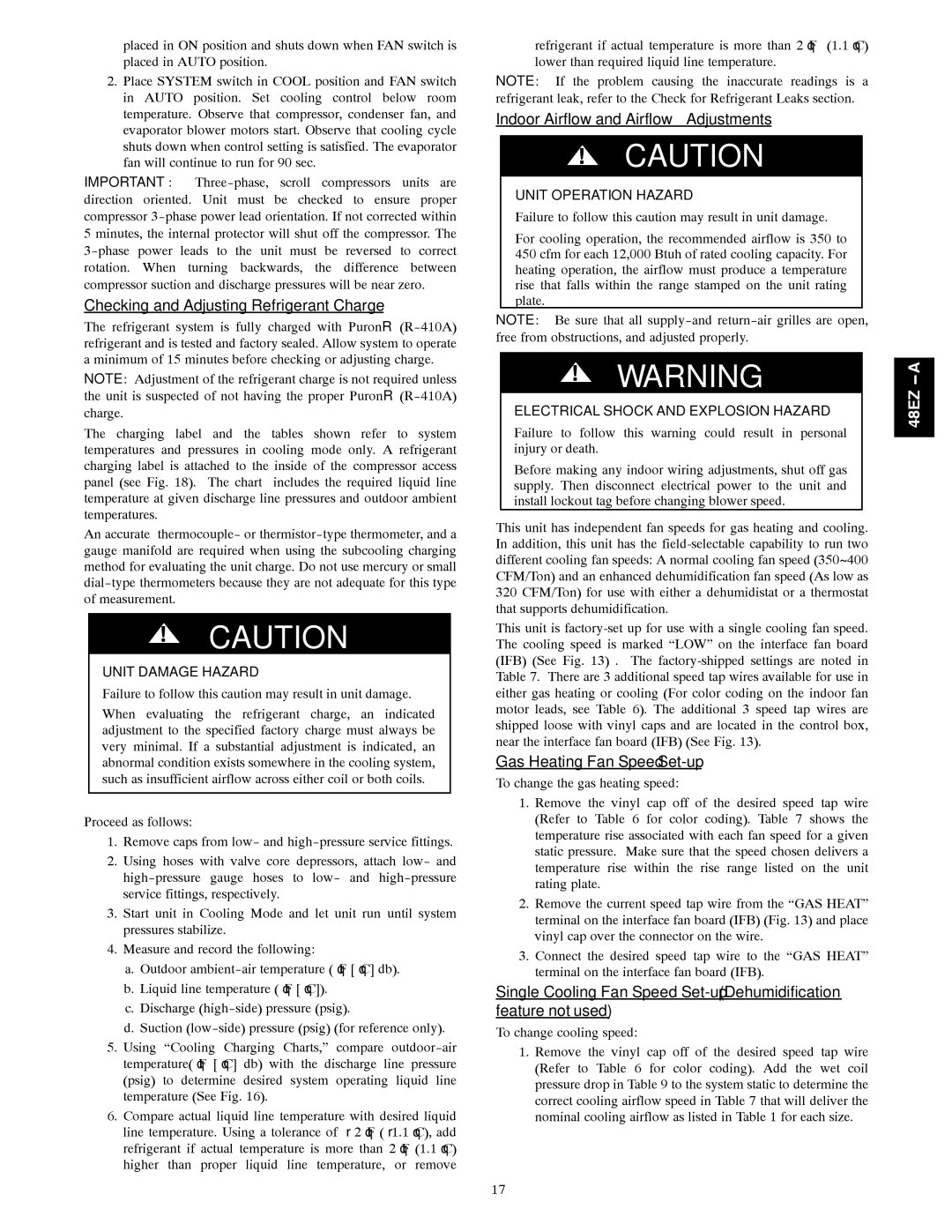
placed in ON position and shuts down when FAN switch is placed in AUTO position.
2.Place SYSTEM switch in COOL position and FAN switch in AUTO position. Set cooling control below room temperature. Observe that compressor, condenser fan, and evaporator blower motors start. Observe that cooling cycle shuts down when control setting is satisfied. The evaporator fan will continue to run for 90 sec.
IMPORTANT:
Checking and Adjusting Refrigerant Charge
The refrigerant system is fully charged with PuronR
NOTE: Adjustment of the refrigerant charge is not required unless the unit is suspected of not having the proper PuronR
The charging label and the tables shown refer to system temperatures and pressures in cooling mode only. A refrigerant charging label is attached to the inside of the compressor access panel (see Fig. 18). The chart includes the required liquid line temperature at given discharge line pressures and outdoor ambient temperatures.
An accurate thermocouple- or
!CAUTION
UNIT DAMAGE HAZARD
Failure to follow this caution may result in unit damage.
When evaluating the refrigerant charge, an indicated adjustment to the specified factory charge must always be very minimal. If a substantial adjustment is indicated, an abnormal condition exists somewhere in the cooling system, such as insufficient airflow across either coil or both coils.
Proceed as follows:
1.Remove caps from low- and
2.Using hoses with valve core depressors, attach low- and
3.Start unit in Cooling Mode and let unit run until system pressures stabilize.
4.Measure and record the following:
a.Outdoor
b.Liquid line temperature (°F [°C]).
c.Discharge
d.Suction
5.Using “Cooling Charging Charts,” compare
6.Compare actual liquid line temperature with desired liquid line temperature. Using a tolerance of ± 2°F (±1.1°C), add refrigerant if actual temperature is more than 2°F (1.1°C) higher than proper liquid line temperature, or remove
refrigerant if actual temperature is more than 2°F (1.1°C) lower than required liquid line temperature.
NOTE: If the problem causing the inaccurate readings is a refrigerant leak, refer to the Check for Refrigerant Leaks section.
Indoor Airflow and Airflow Adjustments
!CAUTION
UNIT OPERATION HAZARD
Failure to follow this caution may result in unit damage.
For cooling operation, the recommended airflow is 350 to 450 cfm for each 12,000 Btuh of rated cooling capacity. For heating operation, the airflow must produce a temperature rise that falls within the range stamped on the unit rating plate.
NOTE: Be sure that all
!WARNING
ELECTRICAL SHOCK AND EXPLOSION HAZARD
Failure to follow this warning could result in personal injury or death.
Before making any indoor wiring adjustments, shut off gas supply. Then disconnect electrical power to the unit and install lockout tag before changing blower speed.
This unit has independent fan speeds for gas heating and cooling. In addition, this unit has the
This unit is
Gas Heating Fan Speed Set-up
To change the gas heating speed:
1.Remove the vinyl cap off of the desired speed tap wire (Refer to Table 6 for color coding). Table 7 shows the temperature rise associated with each fan speed for a given static pressure. Make sure that the speed chosen delivers a temperature rise within the rise range listed on the unit rating plate.
2.Remove the current speed tap wire from the “GAS HEAT” terminal on the interface fan board (IFB) (Fig. 13) and place vinyl cap over the connector on the wire.
3.Connect the desired speed tap wire to the “GAS HEAT” terminal on the interface fan board (IFB).
Single Cooling Fan Speed
To change cooling speed:
1.Remove the vinyl cap off of the desired speed tap wire (Refer to Table 6 for color coding). Add the wet coil pressure drop in Table 9 to the system static to determine the correct cooling airflow speed in Table 7 that will deliver the nominal cooling airflow as listed in Table 1 for each size.
48EZ -- A
17
